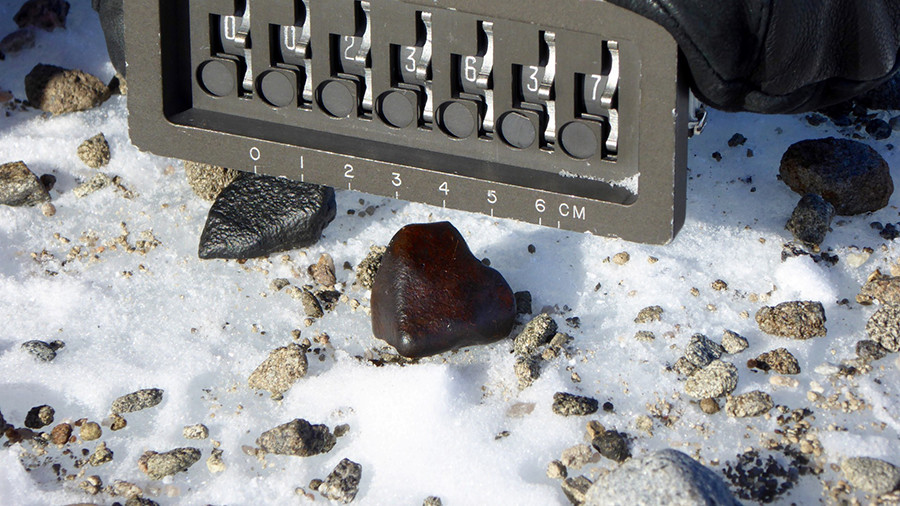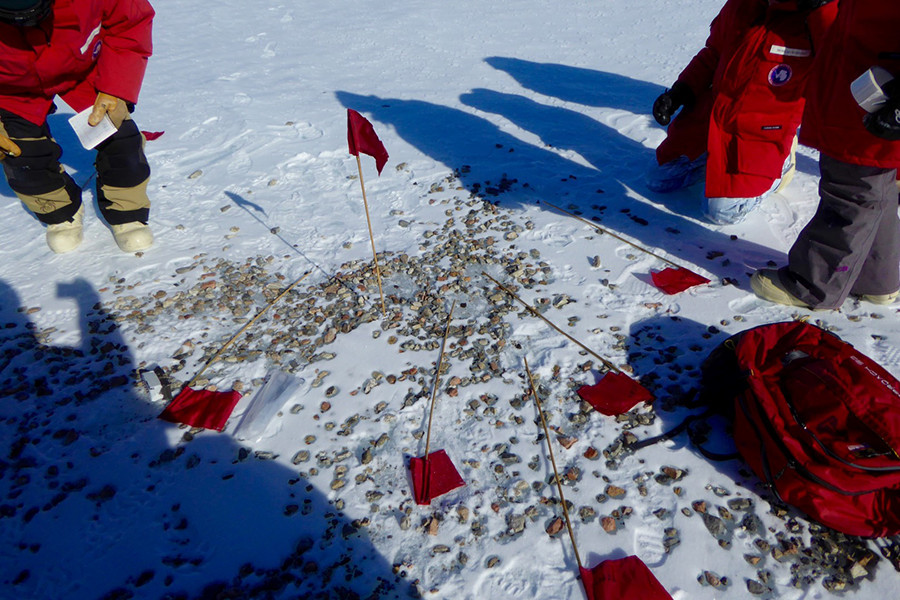Little Pieces of Outer Space on the Frozen Continent (Cont.)Posted July 5, 2016
“As a rock from space falls through the Earth’s atmosphere, and it starts to burn up, they form this black fusion crust. The silica basically starts melting and reforms a coat that’s extremely black and shiny,” said Tsang. “You have this very black patina that forms on these meteorites against the white or blue backdrop of the ice, so it makes searching much easier for us.” 
Photo Credit: Constantine Tsang
Meteorites stand out against the other terrestrial rocks because of their smooth, dark fusion crust.
This black outer layer stands out starkly against the white and blue ice it rests on. Even when there are other rocks nearby, it lets the meteorites stand out. “The fusion crust is definitely the best, telltale sign,” said Crapster-Pregont. “Otherwise, you get really familiar with the terrestrial rocks, and if a rock doesn’t look like any of the terrestrial rocks in the area that you have ever seen, then it’s most likely an extraterrestrial rock or a meteorite of some kind.” Though there are countless meteorites throughout the continent, they’re sparsely distributed. So in order to collect an appreciable amount of samples, the team members have to cover a lot of ground. The majority of the time the team is hunting for samples from the back of their snow machines. The team members ride in a grid pattern, with snowmobiles usually spaced about 30 feet apart. Everyone keeps their eyes on the ground, looking for any dark lumps sticking out against the blue ice. It’s a carefully planned, systematic search so that future teams can come in and fill in gaps during subsequent seasons. “Mostly we’re cruising around on snowmobiles,” Martinez said. “Sometimes we go to areas where there are higher concentrations of terrestrial rocks, like the moraines, and in those places we’ll get off the snowmobiles and search on foot.” For eight hours a day, they drove along at about five miles an hour, scanning the ice. When they come across anything unusual, they’ll go in for a closer look. No sample is too small to be investigated. “Every time that we see a rock, we stop,” Lanza said. “When we think we found a meteorite you make the international sign for ‘come here’ which is waving your arms in an X.” If the rock looks promising, they’ll collect it and send it back to the United States for full identification. Without ever touching the sample directly, members of the team photograph it, write down a few notes about its surroundings and estimate its dimensions before using tongs to place it in a sterilized plastic bag with an identification tag. After it’s bagged and tagged, each sample is carefully placed in the collection box, and the team resumes their search. At the end of the season, all of the samples are flown in a refrigerated shipping container back to McMurdo Station, where they’re kept in sub-zero temperatures, until the container is loaded onto a cargo vessel headed to Port Hueneme in California. While still frozen, they’re driven halfway across the country to the Johnson Space Center in Houston Texas.
The idea is to build up as large a library as possible of samples from the far reaches of the solar system.
Once they reach the center’s meteorite lab, scientists start to analyze them more carefully to determine what kinds they are and where in the solar system they may have originated. They’ll get catalogued, and carefully thawed. “They will be very slowly dried out under nitrogen because we don’t want them to rust,” Evans said. The meteorites will stay in boxes filled with pure nitrogen as they’re carefully measured and sliced into thin sections that are most useful to researchers. “Once that’s complete the samples will get announced; once a sample is announced it’s available to the community to study.” Any researcher in the world studying planetary science can look at the catalog and apply to receive samples. Like taking a book out of the library, these scientists will be the ones conducting research and making new discoveries with the recovered meteorites. “ANSMET itself is more service than science,” Harvey said. The idea is to build up as large a library as possible of samples from the far reaches of the solar system. Already the program has collected more than 21,000 meteorites over the 40 seasons it’s been operating. But Harvey says that there are still a lot of unexplored sites to visit and new samples to collect. 
Photo Credit: Constantine Tsang
Though teams have been searching different areas for almost 40 years, there are still many locations still to be visited.
“It may seem like we have a huge collection of meteorites, but in fact these meteorites represent a really really rare event where a little bit of stuff out in the solar system gets in the way of the Earth and its orbit,” Harvey said. He added that the collection is really only just beginning. “We’re at a place where there are still huge holes in our catalogue.” Most of the meteorites in the collection are what are known as chondrites, stony space rocks that are leftovers from when the solar system was first coalescing out of clouds of dust and gas more than 4.5 billion years ago. They come from asteroids that were never part of a celestial body large enough for gravity to separate it into a core, mantle and crust. Chondrites are essentially the building blocks of planets and moons that never quite made it into one, and they give scientists an unprecedented window into the primordial history of our corner of the cosmos. When the team comes across more unusual finds, like pieces of the asteroid Vesta, Earth’s moon and Mars, they get a chance to learn more about the planetoids they originated from. These rocks not only tell scientists about the history of distant space bodies, but can help them understand more about Earth’s own past. “We see a history of Mars written in those rocks that suggest a planet where water was going away and the climate was changing, and you naturally kind of wonder why… Why did the water stay on our planet, or have we lost water and didn’t even know it,” Harvey said. “We can answer these questions for our own planet, or try to, but it’s really really good to have a second planet to use as a counterexample or as a control.” There are surely countless more meteorites from all corners of the solar system waiting to be discovered across Antarctica. NASA just funded the program for another five years and though Harvey said that their work around the Miller Range is nearly done, there are numerous more areas they’ve identified that look promising. “The problem now is more along the lines of ‘Can we get someone there? Can we get some boots on the ice and look around?’” Harvey said. “We still have dozens of places we’d like to go to, and dozens of seasons more work out in front of us.” NSF-funded research in this article: Ralph Harvey, Case Western Reserve University, Award No. 0839168 |
"News about the USAP, the Ice, and the People"



For USAP Participants |
For The Public |
For Researchers and EducatorsContact UsNational Science FoundationOffice of Polar Programs Geosciences Directorate 2415 Eisenhower Avenue, Suite W7100 Alexandria, VA 22314 Sign up for the NSF Office of Polar Programs newsletter and events. Feedback Form |



